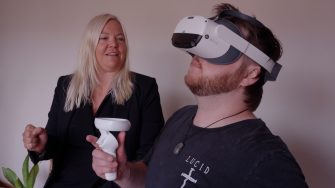New hope for mobility after injury
Professor Sylvia Gustin leads Project Avatar, which aims to restore sensation after a complete spinal cord injury, giving hope to up to half of patients.
Professor Sylvia Gustin leads Project Avatar, which aims to restore sensation after a complete spinal cord injury, giving hope to up to half of patients.

There are two known types of spinal cord injury. A person with a complete spinal cord injury can't feel or move below their level of injury. Those with an incomplete injury can only partially feel and move below their level of injury.
But recent research shows around 50 per cent of complete spinal cord injury patients still have messages from touch travelling to the brain. The brain cannot identify the signal as touch, so it becomes ‘noise’. And this is where Project Avatar can help identify this signal correctly—by retraining the brain and restoring sensation.
Professor Sylvia Gustin from the UNSW School of Psychology is using immersive virtual reality experiences to ‘trick’ the brain with perceptions of feeling such as walking, climbing and more.
A patient moves as an avatar in a virtual world, while receiving corresponding tap stimulation in the real world. This enforces the signal from the point of touch to the brain—teaching and conditioning the brain to recognise the signal as sensation again.
“The brain is an extraordinary organ,” Prof Gustin said. “The brain is dynamic, it’s not static. I want to change the function of the brain so that we can recover from neurological disorders such as spinal cord injury.”
Project Avatar is a UNSW Sydney partnership with Neuroscience Research Australia (NeuRA).
"50 per cent of people with a complete spinal cord injury still have surviving nerve fibres in their spine. We want to enhance these nerve fibres, so hopefully they can feel again"
UNSW research participant James Stanley acquired a complete spinal cord injury when learning how to surf. His injury is rare—surfer's myelopathy—which is caused by a hyperextension of the back.
He says being strapped into the virtual world can be disorienting at the start, “because when you look down, you’re actually looking down at legs standing up, not sitting down so it sort of throws off your centre of gravity,” Mr Stanley said.
“The great thing about James’ story is when he came to [us] to trial our device for the first time, a week later after our first treatment James called me and said ‘Sylvia, this is unbelievable,” Prof Gustin said. “I suddenly can bend over. I suddenly can use muscles I haven’t used since my injury.”
Mr Stanley says his body has started to remember what it felt like to walk when he used to walk. “Even when you to step down off a rock or climb a mountain your body again mimics that and leans back as you go through it,” he said.
“It’s really hard to describe the emotions that run through your brain when something like that occurs.”
Restoring sensation to parts of the body and being able to feel signs of infection or pain from injuries is important for well-being and life expectancy. On the mental health side, it’s also important for quality of life.
“I’ve now been able to do other things like pick up my dog, which I was never able to do,” Mr Stanley said. “Even picking up my niece. I never thought I could just try and pick her up without having to hold onto something.”
“Living in a wheelchair is bloody hard. And what I hope to see from the research … I’m hoping that changes to ‘alright, you’ve had your accident, but these are the options now with what we can do."
- James Stanley, UNSW research participant
Developing new therapies and hospital protocols for spinal cord injuries can help retrain and rewire the brain, creating new pathways for brain cells to ‘talk’ to one another.
With further research and progress Project Avatar aims to improve knowledge around restoring sensation after a complete spinal cord injury, giving hope to up to half of patients with future injuries.
"What we want to do with Project Avatar is to change what is expected from a life of spinal cord injury. Using a novel, cutting edge treatment, we hope to restore sensation in people with a complete spinal cord injury worldwide."
- Professor Sylvia Gustin, School of Psychology
Impact stories